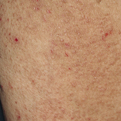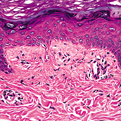Lichen Amyloidosis
General Information
Lichen Amyloidosis has been found to be linked endocrine neoplasia type 2A (MEN 2A) also known as Sipple syndrome. Lichen amyloidosis is usually localized to the interscapular region consisting of lichenoid papules with hyperpigmentation and fine scaling. It is found in the papillary dermis, usually at the tip of the dermal papillae. The cause of the amyloid deposition is associated with marked pruritus secondary to cholestatis. The clinical appearance is red-brown hyperkeratosis papules commonly seen on the pretibial surfaces, but can also appear on the feet and on the thighs of the patient. Treatments are directed for the relief of the pruritus. Treatments include sedating antihistamines, topical steroids, intralesional steroids and topical dimethyl sulfoxide. Surgical care included laser vaporization, dermabrasion and excision of individual lesions; however, lesions usually recur after these treatments.
Epidemiology
More common in persons of Chinese ancestry with a higher percentage shown in males around the ages of 50-60
Etiology
Amyloid deposition in the skin
Pathogenesis
Yet to be determined
Clinical
Intensely pruritic, red-brown hyperkeratotic papules
Histology
Amyloid deposition in the papillary dermis and hyperkeratosis and acanthosis of the epidermis
Bibliography
1. “Amyloidosis, Lichen” (Online) March 2007. http://www.emedicine.com/derm/topic16.htm (visited: March 21, 2008)
Download PDF
![]() Lichen Amyloidosis
Lichen Amyloidosis


